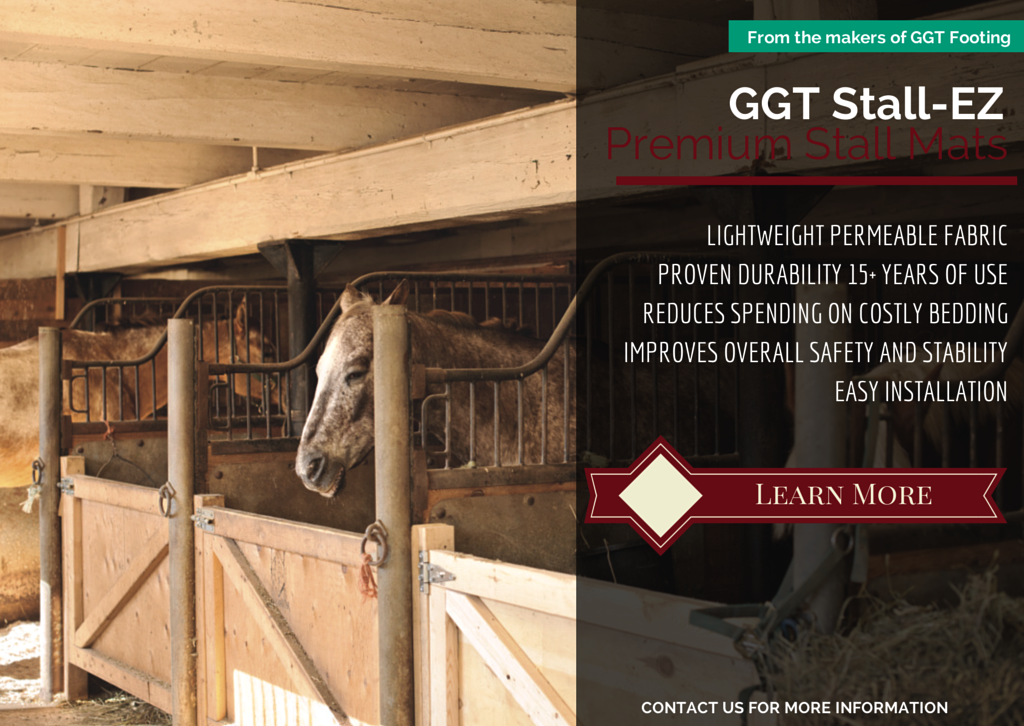Stall flooring has a profound impact on the fitness and welfare of horses, particularly of horses that spend considerable amounts of time in their stalls. The ideal floor is one that: has some softness to decrease strain on the horse's legs; is non-slippery; remains dry; does not retain odors; is durable; and is easy to clean.
Clay vs. concrete
Stall floors can be split into two major classes, impervious or permeable. With impervious flooring (most often concrete), the surface does not absorb liquids and instead encourages liquids to flow down a slight slope to a drain. In permeable flooring, the surface is designed to absorb liquids and pull them away from the surface. Permeable flooring is often clay laid over gravel, or some similar construction.
Both types of flooring have their problems. Permeable flooring is soft and non-slippery, but it can become damp, can retain odors, cannot easily be cleaned off, and is not durable. Anyone who has been in a stable with older permeable flooring is aware of the problem of horses' digging into permeable floors. Many stalls resemble large holes rather than level surfaces. Such flooring needs to be regularly reconstructed in order to provide a flat, comfortable surface.
Impervious flooring, namely concrete, has many advantages. It is much more durable than clay floors. It does not retain odors and can easily be hosed off during cleaning. If the floor is given the correct slope during construction it drains well and remains dry. The only problem is that it is very hard and can be damaging and stressful to the legs of horses who have to stand on it for hours. It can also be slippery to the shod hoof.

Rubber mats
One solution to the hardness/slipperiness problem is to lay down rubber stall mats over the concrete; and many people also lay rubber stall mats down over clay flooring to stop horses from digging. These certainly improve the comfort of the stall for the horses. However, liquid accumulates on the rubber mats and cannot drain away easily. The surface can become damp and smelly, and release significant amounts of toxic ammonia into the barn's air. Using large amounts of bedding to absorb the liquids is one solution, but bedding can be quite expensive.
Stall-EZ
GGT-Footing has created an alternative to the traditional rubber stall mat, the Stall-EZ. This stall liner is a one-piece seamless mat woven out of a permeable, durable material. This stall liner provides the comfort of a stall mat without the mess of a stall mat. Urine and other liquids can easily drain out through the mat to the flooring underneath, where it can then drain away. No more smell or ammonia build-up. Because the liquids drain away, less bedding is needed. Savings on bedding costs and on labor to remove and replace bedding on a daily basis can pay for the mats many times over.
The GGT Stall-EZ mats are also lightweight. Traditional rubber stall mats can be unbelievably heavy, around 500 pounds per stall. The GGT stall mat only weighs around 40 pounds. It can easily be removed to clean underneath it. It also doesn't cause damage to the underlying floor due to its weight. Heavy rubber mats can cause underlying clay floors to become uneven over time.
Due to their weight, many rubber stall mats come in interlocking pieces. Bedding can leak down through the seams and accumulate underneath the mat, creating odor problems. Horses can also catch their shoes or delicate skin on the seams, or actually get a leg caught underneath one of the heavy mats. The one-piece design of the GGT mats means no seams, no leaks and no injuries.
We are a certified GGT distributor. Don't hesitate to contact us about GGT stall mats. If you are considering upgrading your arena footing or building a new arena, we can help you.


